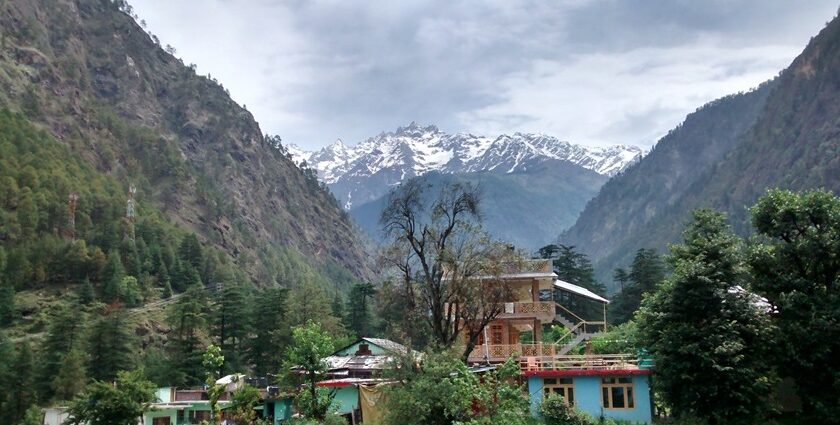Snowfall in Kasol shifts the whole mood of the valley; everything slows down and turns still. The lively riverside village suddenly turns calm, tucked under layers of white. Pine trees lean heavily with snow, rooftops disappear, and narrow trails turn soft and silent. The Parvati River keeps moving slowly beside the frozen paths. Around you, villages like Tosh, Chalal, and Kheerganga glow under the pale winter sun. It isn’t really about the view; it’s the quiet that gets into you and doesn’t leave, even when you’re back home.
Quick Details About Snowfall In Kasol
Elevation: 1,580 metres (5,180 ft) above sea level
Typical First Snowfall: Late December
Peak Snow Months: January and February
Winter Temperature: −4°C to 10°C
Major Water Body: Parvati River
Famous For: Cafés, mountain treks, and relaxed riverside stays
Location
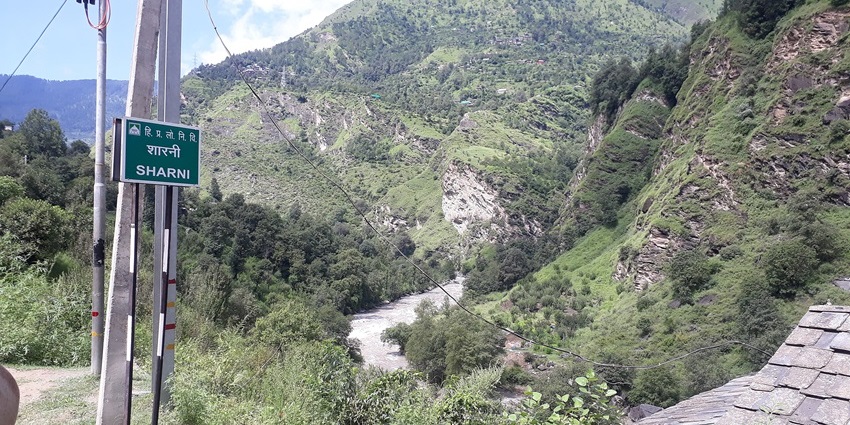
Photo: Pinakpani / Wikimedia Commons
Kasol is a small village by the Parvati River in Himachal Pradesh’s Kullu district. It sits on the route between Bhuntar and Manikaran Sahib, a stop for trekkers heading toward Chalal, Tosh, Kheerganga, or Grahan. The river cuts through the middle of the village, with a narrow bridge linking both sides. When the season deepens, the Parvati River turns a sharp icy blue, and the trails fall quiet. The forests look silver in the cold light, and nearby hamlets like Tosh and Pulga lie covered in snow. Kasol is about 30 to 35 kilometres from Kullu town, close enough for an easy trip, but far enough to feel completely apart from the noise.
Suggested Read: Places To Visit In Himachal Pradesh For Your Next Vacation
How To Reach
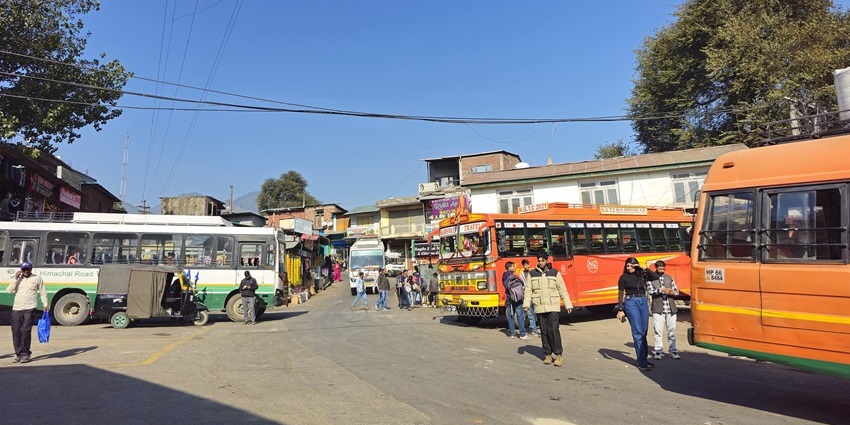
Photo: Gannu03 / Wikimedia Commons
By Air: The nearest airport is Bhuntar, about 31 kilometres away. Flights come in from Delhi and Chandigarh, but winter fog can affect schedules. From Bhuntar, it’s an hour’s drive to Kasol by taxi or local bus. If you want a smoother connection, many travellers prefer flying into Chandigarh instead and covering the rest of the distance by road.
By Rail: The nearest big railway station is Pathankot Junction, around 150 kilometres from Kasol. From there, you can take a smaller train to Joginder Nagar and continue the rest of the way by taxi or bus.
By Road: You can reach Kasol through NH 3 up to Bhuntar, and then follow the Kasol – Manikaran road for the final 30 kilometres. Overnight buses run regularly from Delhi, Chandigarh, and Manali. In winter, it’s best to start early from Bhuntar or Kullu since fog and light snow can make evening travel tricky near Jari and Manikaran.
Things To Do During Snowfall In Kasol
Kasol in winter slows down in the best way. The air feels still, the wooden rooftops wear a thin cover of snow, and the Parvati River runs quietly under a veil of mist.
1. Walk Along The Snowy Parvati River Trail
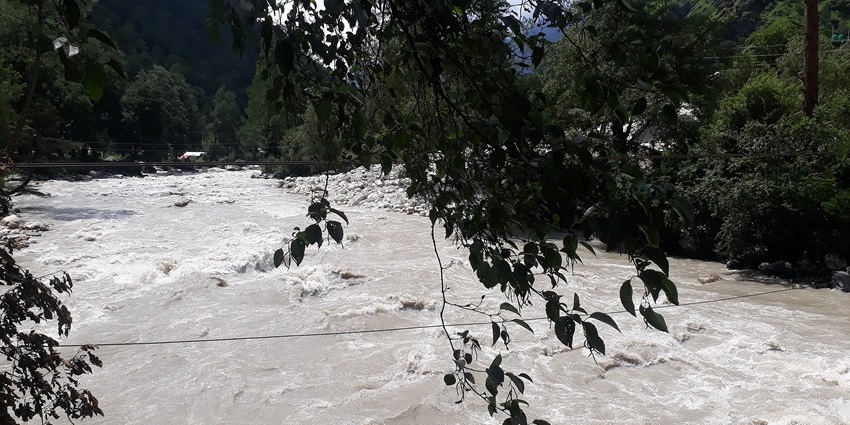
Photo: Pinakpani / Wikimedia Commons
Walking along the Parvati River is one of the nicest things you can do in Kasol. The river runs right through the village, and in winter its bright turquoise colour stands out sharply against the white snow on the banks. Start near the Kasol bridge and follow the trail toward Chalal or Manikaran. The path winds through pine trees powdered with snow, past frozen puddles that catch the light, and over small wooden bridges that make you stop for a photo. Go early in the morning if you can; it’s quiet then, just the river moving and the sound of snow crunching under your shoes.
Suggested Read: Places To Visit In Kasol
2. Explore Chalal Village Trek
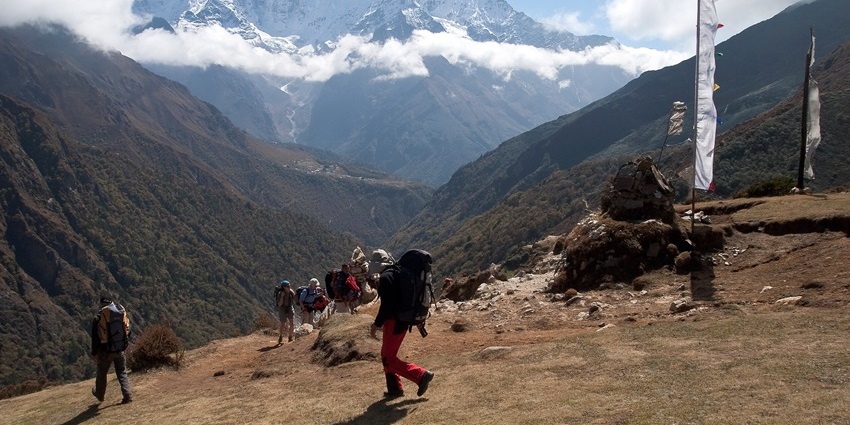
Photo: Vyacheslav Argenberg / Wikimedia Commons / Image For Representation Only
Just across a small suspension bridge from Kasol, the walk to Chalal Village feels like stepping into silence. The trail winds through pine trees dusted with snow and along the bends of the frozen Parvati River. During snowfall in Kasol, it’s even more peaceful; you hear the crunch of snow under your feet and the soft rush of the river beside you. Wooden houses are spread along the slope, thin lines of smoke curling up from their chimneys. The walk to the village takes around half an hour, slow, simple, and easy, even if you’re not used to trekking.
3. Enjoy Local Cafés And Bonfire Evenings
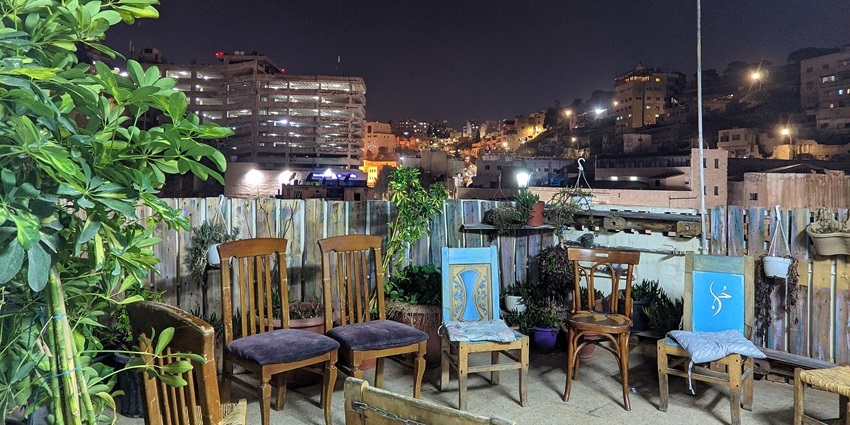
Photo: Taha Al-Hayali / Wikimedia Commons / Image For Representation Only
Kasol feels even warmer when winter sets in. As snowfall in Kasol begins, travellers drift into riverside cafés like Evergreen, Moon Dance, or Jim Morrison Café, places where soft music plays, the pizza comes straight from a wood fire, and mugs of hot chocolate never stay full for long. By evening, the whole valley smells of pine smoke. Bonfires burn outside hostels and cottages, and people gather close, trading stories over cups of herbal tea. Snow falls lightly in the background, catching the light from the lamps.
Suggested Read: Things To Do In Kasol
Places To Visit In Kasol During Snowfall And Around
During winter, Kasol and the nearby villages have their own charm, a mix of calm, adventure, and the kind of Himalayan views that make you stop and stare.
1. Manikaran Sahib
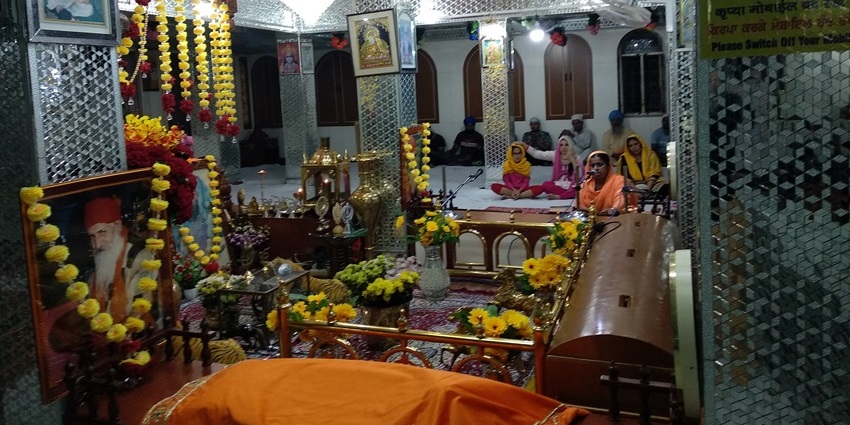
Photo: Accesscrawl / Wikimedia Commons
Manikaran Sahib sits just 5 kilometres from Kasol. It’s a Gurudwara known for its natural hot springs that somehow stay warm even in the middle of winter. Steam rises through the falling snow, a sight that stops you for a moment. Pilgrims slip into the geothermal pools to shake off the cold, and inside, the langar keeps serving hot food to anyone who walks in, a mix of warmth and comfort that feels almost unreal in that weather. During snowfall in Kasol, this place becomes a quiet, spiritual pause in the middle of the mountains.
Altitude: 1,760 metres
Known For: Natural hot springs and Gurudwara langar
2. Chalal Village
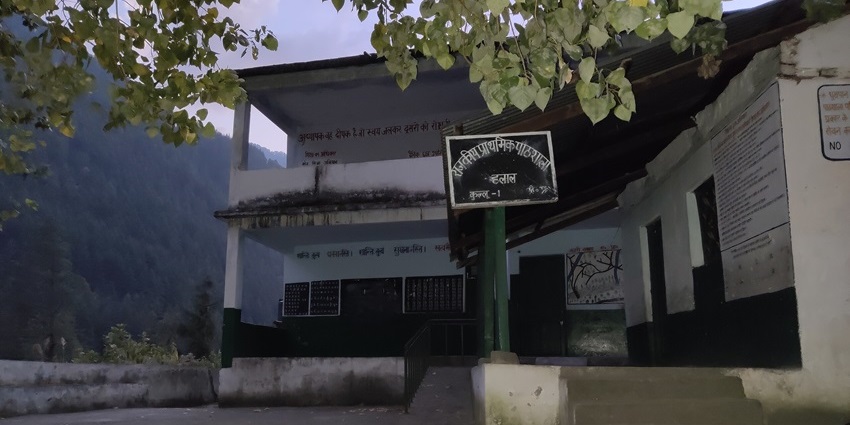
Photo: Stalinjeet Brar / Wikimedia Commons
Just a short 20-minute walk from Kasol, across a hanging bridge, Chalal Village feels like a small hideaway inside the forest. In winter, the trail narrows between snow-covered pine trees and frozen bends of the river. Wooden houses stand along the slope, thin smoke rising from their chimneys, giving the place an old-mountain warmth. A few cafés and homestays stay open even in the coldest weeks, making it an easy spot to rest or warm up. The walk takes only half an hour, perfect for beginners.
Altitude: 1,670 metres
Known For: Forest walks, riverside views, and peaceful cafés
Suggested Read: Things To Do In Himachal Pradesh
3. Tosh
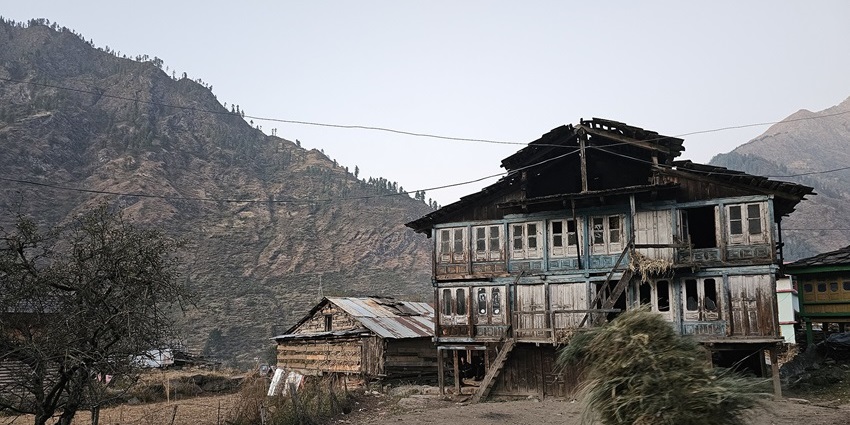
Photo: Gannu03 / Wikimedia Commons
Around 20 kilometres from Kasol, Tosh Village sits high above the Parvati Valley and gets some of the heaviest snow of the season. The drive to Barshaini and the short uphill walk to the village pass frozen waterfalls, quiet pine forests, and mountain cafés half-buried in snow. From Tosh, the view opens wide, white slopes stretching into the valley, glowing pink when the sun begins to set. Many travellers spend a night here just to feel the stillness. The rooms stay warm, wood fires burn slowly, and the sky fills with stars once the power cuts out.
Altitude: 2,400 metres
Known For: Snow-covered wooden houses and sunset views
4. Kheerganga
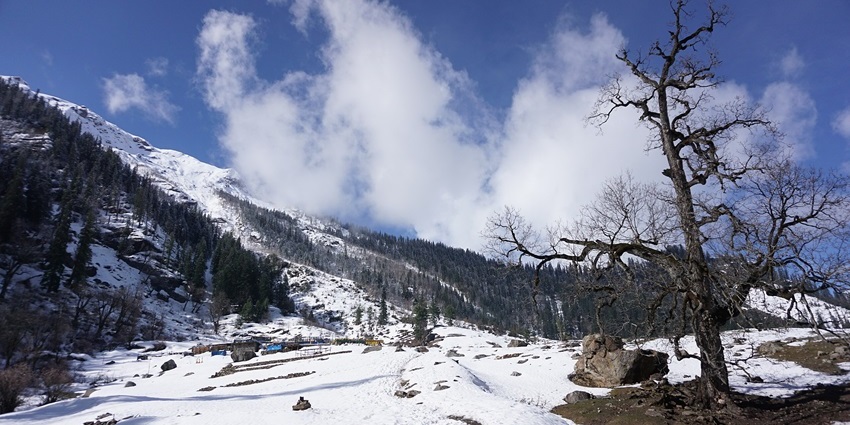
Photo: Vishrutpanday / Wikimedia Commons
The trek to Kheerganga starts from Barshaini and runs about 12 kilometres. In winter, it’s something else. The trail cuts through thick deodar forests where the snow piles up quietly, and icicles hang low from the trees. Every few minutes, you hear the crunch of fresh snow under your boots. When you reach the top, the forest opens into a flat white meadow with a few camps standing in silence and steam drifting from the hot spring.
Altitude: 2,960 metres
Known For: Natural hot spring and panoramic snow meadows
Suggested Read: Kheerganga Hot Spring
5. Grahan Village
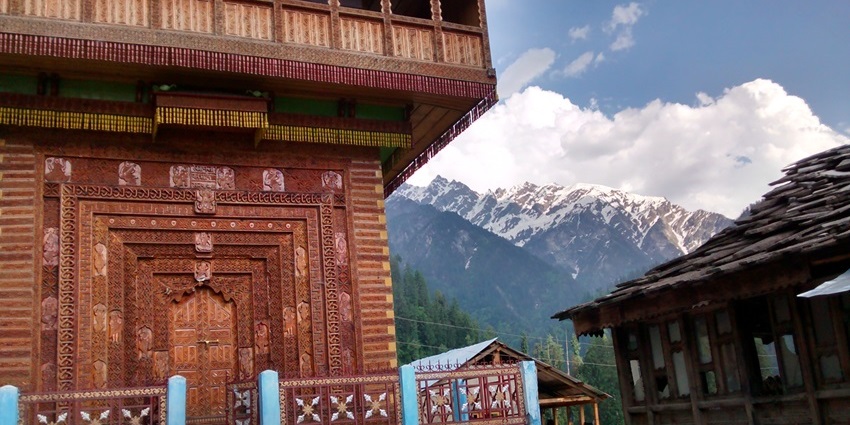
Photo: Gshashidhar125 / Wikimedia Commons
Grahan Village is a small, lesser-known place near Kasol, reached by an 8-kilometre forest trail that turns white during snowfall in Kasol. The path climbs slowly through oak and pine trees, opening every now and then to wide views of frozen ridges. At the end, the village appears quietly, with wooden houses, small terraced fields, and smoke rising from chimneys. Locals usually invite visitors in for chai near the fire, happy to talk while snow keeps falling outside.
Altitude: 2,300 metres
Known For: Traditional Himachali homes and forest trek
Where To Stay
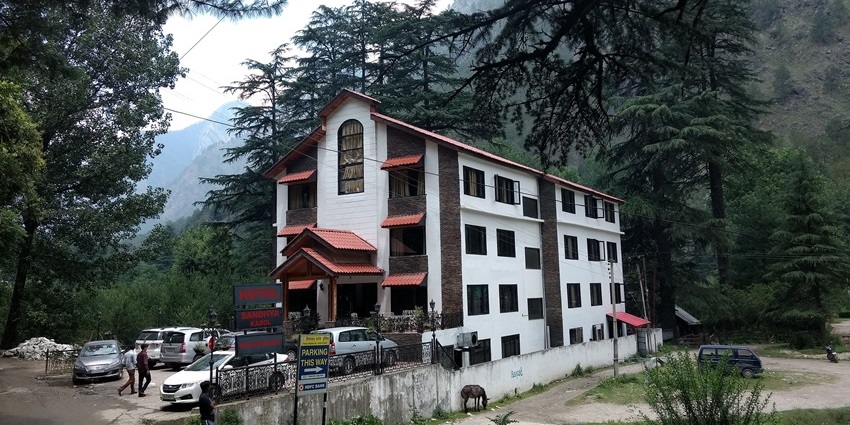
Photo: Amritanshu Ankit / Wikimedia Commons / Image For Representation Only
Finding a warm place to stay in Kasol during winter isn’t hard; you just need to pick the right spot. You’ll find riverside cottages, small hostels, and wooden lodges that all open to snowy views. The Himalayan Village, Parvati Kuteer, and Brick and Wood Cottages have heated rooms, fireplaces, and balconies that look straight at the mountains. Whoopers Hostel, Nomads Hostel, and The Hosteller Kasol work well for backpackers; they’re lively at night with bonfires and music. Chalal and Tosh offer quieter stays by the river or on the slopes, a little away from the crowd.
Suggested Read: Top Places To Visit Near Kasol On Your Next Trip To The Hills
Where To Eat
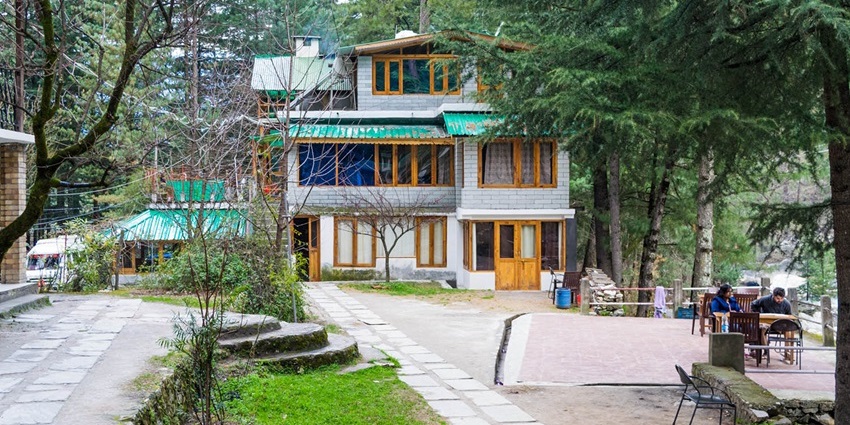
Photo: Ashish Gupta / Wikimedia Commons / Image For Representation Only
Kasol’s food scene stays alive even through the cold. The cafés stay warm, the food tastes richer, and everything feels slower, perfect for winter evenings. Evergreen Café is a favourite for its Israeli platters, wood-fired pizzas, and mugs of hot chocolate with a mountain view. Moon Dance Café is a great breakfast spot with fresh bakery items and a view of the Parvati River. Jim Morrison Café has chill music, warm indoor seating, and that easygoing vibe people come to Kasol for. Bhoj Café is a good stop for a quick chai or a plate of steaming momos after a walk in the snow. Manikaran Langar offers simple, authentic community meals near the hot springs, a different kind of warmth altogether.
Best Time To Visit
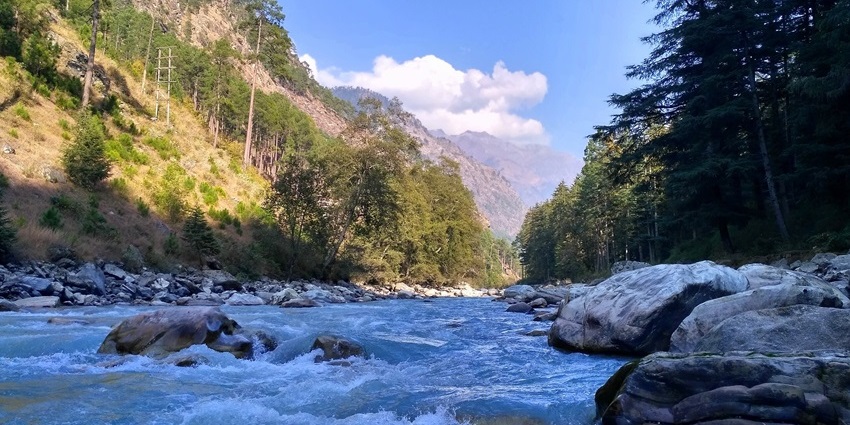
Photo: L K Harshavardhan / Wikimedia Commons
The best time to see snowfall around Kasol is from late December to mid-February. During these weeks, nearby villages like Tosh, Kheerganga, and Grahan stay covered in snow, and the valley turns quiet under the cold. Temperatures usually range between −4°C and 8°C, and the Parvati River moves slowly under frozen edges.
January is when you’ll find the heaviest snow and the fewest people around, great if you want calm and white landscapes everywhere you look. By early March, the cold eases a little, the trails open up again, and the upper slopes start to melt, leaving a mix of snow and sunshine perfect for trekking.
Suggested Read: Places To Visit In Himachal Pradesh In October
Tips For Travellers

Photo: Timur Weber / Pexels / Image For Representation Only
- Pack plenty of warm layers, thermals, gloves, and waterproof shoes with a good grip.
- Begin treks early; trails get slippery once the sun goes down.
- Keep some cash on you since ATMs in Kasol and Tosh often run out.
- Keep sipping water; it’s easy to get dehydrated in cold weather.
- Before booking, double-check that your stay has heating or electric blankets. Nights drop well below freezing.
- For Tosh or Barshaini, hire local drivers who know how to handle snow-covered roads.
- Always look up the weather before heading to Kheerganga.
- Be mindful around Manikaran Sahib, and don’t leave trash behind on the forest trails.
Snowfall in Kasol turns the Parvati Valley into something out of a dream. Pine trees shine with frost, and the river slips quietly under a thin sheet of ice. The cafés stay warm and golden against the cold outside. You can spend the day soaking in the hot springs at Manikaran, walk the snowy trail to Tosh, or just sit by a fire while the mountains fade into mist. Plan your next Himalayan trip with TripXL, explore Kasol’s winter trails, meet the locals, and see how peaceful Himachal looks when everything is wrapped in snow.
Cover Photo: Gshashidhar125 / Wikimedia Commons


 WhatsApp
WhatsApp
 Twitter
Twitter
